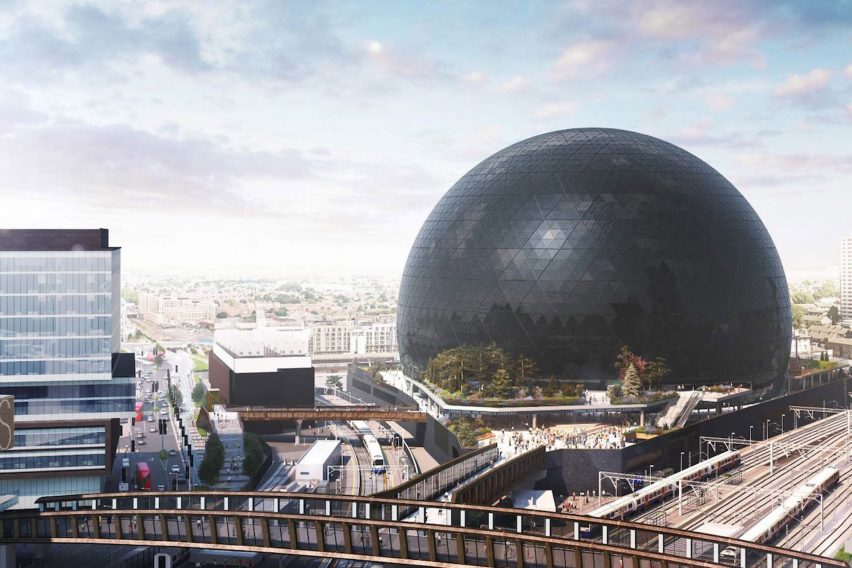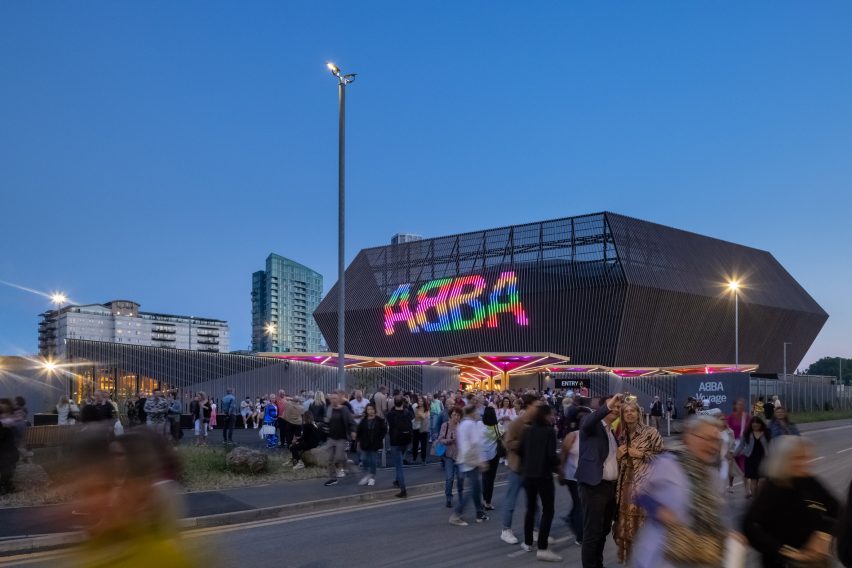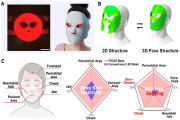
Following recent controversy over proposals for an MSG Sphere in London similar to Las Vegas's new light-up venue, Dezeen examines the arguments on both sides of the debate.
Should London build a Sphere? The colossal Las Vegas venue – not spherical, more like a ball sliced in half with an exoskeleton of light-emitting diode (LED) screens – has captivated audiences since it opened in October, with mind-bending immersive shows and animated exterior displays.
The $2.3bn Sphere sits just off the Strip on Sands Avenue, where it transmutes into illuminated moving-image novelties: a blinking eyeball surveying the city, perhaps, or a beguiling emoji.
London Sphere planned since 2018
Madison Square Garden Entertainment (MSG), the organisation behind the venue, wanted to build a Sphere on a former coach park at Stratford in east London, starting the planning process in 2018 – long before the Vegas building was completed.
Supporters saw a London Sphere as a game-changer for the city's status, a vote of confidence in the UK capital and a chance to revive a battered live music industry post-pandemic.
But critics – including Stop MSG Sphere, a residents' campaign – were alarmed by the potential impact on neighbouring homes, and feared a detrimental effect on the aesthetics of the wider city. One campaigner described the proposal as "a supersized fever dream".
Relevant planning authority the London Legacy Development Corporation (LLDC) was minded to approve proposals. But last month, residents and some rival venues were relieved when London mayor Sadiq Khan directed the LLDC to reject MSG's plans, citing "unacceptable harm to hundreds of residents" through light intrusion.

MSG Sphere Las Vegas opened in October. Photo by Sphere Entertainment
Khan also cited undue dominance in scale, massing and design on the east London skyline (the proposed structure is 90 metres high), excessive energy consumption and harm to local heritage assets.
In November, UK government housing secretary Michael Gove intervened by using his power to "call in" that rejection, and could potentially overturn it.
Planning permission for the Sphere, and a separate application for advertisement consent, will now be decided by ministers in the Department for Levelling Up, Housing and Communities.
The off-again, on-again London Sphere has presented an entirely new architecture and planning conundrum. The structure, designed by global architecture firm Populous, is part-building, part-animated billboard.
If it goes ahead, it would be like nothing else in Europe, with the main venue's capacity 10 times that of the
Outernet in London's West End at 21,500 people, and many times more imposing.
When exterior screens are turned off, the biggest illuminated billboard in Europe would be a piece of blank geometry. An absence of facade detail means few of the usual debates about style and expression apply.
Instead, the discussion, and the mayor's objections, are mostly concerned with the imposition of technology and quality of life.
Given its height, the Sphere would be visible over a much greater distance than digital advertising screens at Piccadilly Circus or Hammersmith flyover – though unlike its sibling in Vegas, the exterior would not have been illuminated 24 hours a day.
"Interesting and futuristic"
"The Sphere wouldn't work on the River Thames, in Westminster, or in Kensington," said
Ike Ijeh, an architect, critic and author who grew up in east London and describes himself as "pro-Sphere – with reservations".
"But Stratford is essentially a new city in its current incarnation, with the V&A, the Queen Elizabeth Park and Westfield," he added. "It is big enough to accommodate distinctive shapes."
Having hosted the Olympic Games in 2012, Stratford has been here before when it comes to arguments about flagship new buildings, Ijeh points out.
"The [neighbouring]
Aquatics Centre [designed by Zaha Hadid Architects] was highly controversial when it was first built in 2011, in what now seems like a different world. It is sculptural and elegant now. So why not the Sphere?"
"The principle of a visually striking, constantly changing backdrop is interesting and futuristic and works with the context."
 MSG wanted to build a Sphere on a former coach park in Stratford, but says it is now focusing on other cities. Image courtesy of MSG
MSG wanted to build a Sphere on a former coach park in Stratford, but says it is now focusing on other cities. Image courtesy of MSG
Entertainment groups, too, are broadly in favour of a London Sphere to reinvigorate nightlife in the post-pandemic era.
"It's a huge opportunity for London," said Night-Time Industries Association CEO Michael Kill. "It would start to build back credibility, it would draw long-term investment, tourism, jobs and a plethora of other things."
But such optimism is misplaced, argues Richard Sennett, a professor of sociology at the London School of Economics and a writer on urban planning and development.
Sennett predicts the Sphere will "work like a negative magnet, repelling any building or other activity around it, save parking".
"It looks to tear a hole in the urban fabric, which is fragile in this part of London," he said. "The Olympic Park needs more connections to its surroundings, not further isolation."
Campaigning residents deny their objections amount to Nimbyism and say they will fight on. "We are angry at a return to anxiety and stress about the possibility that this might still happen," a spokeswoman for Stop MSG Sphere told Dezeen.
She is unmoved by MSG's offer to supply black-out blinds to residents whose homes might be affected.
"Our two options are either to be lit up or to be plunged into darkness, which is laughable," she said. "People need light, and it will be particularly egregious before sunrise and after sunset. People shouldn't have to plunge their properties into darkness in order to escape it."
She points, too, to the Las Vegas Sphere's dominance, with reports of distracted drivers, some of whom are slowing down and even abandoning their cars to take pictures.
"A supersized fever dream"
The Sphere taps into wider debates than the usual planning arguments. Veronica Wignall of pressure group Adfree Cities says the proposed structure feeds into a concern that "the spread of digital advertising infrastructure is running largely unchecked".
Her organisation's Living Next to Digital Billboards report, published in 2021, found light pollution and intrusion from digital screens had a detrimental effect on social cohesion, mental health and ecology. Such screens disproportionately affect lower-income households, she claims.
"The MSG proposal is a supersized fever dream of the problems faced by people living near digital advertising billboards," she said. "They want a peaceful neighbourhood, good quality sleep, to feel cared for and a sense of place. That does not include a commercial presence that is irrelevant to you and your needs."
Nevertheless, London's appetite for so-called immersive shows and technically enhanced spectacles is growing – as the success of Lightroom in Kings Cross, Abba Voyage in Stratford and Yayoi Kusama's Infinity Mirror installation at Tate Modern have shown.

The ABBA Voyage virtual reality concert venue, also in Stratford, has been hugely popular. Photo by Dirk Lindner
As US-based immersive-entertainment designer Mikhael Tara Garver puts it: "We are in a loneliness epidemic, and we're craving experiences. The leap and the risk taken with the Sphere is absolutely the direction we have to go."
But Gove's intervention looks likely to be too late. In an ill-tempered statement last week, MSG said it was abandoning its London project, saying Khan had "hijacked" the planning process with a "politically motivated" decision.
MSG chief executive James Dolan elaborated in an interview with the Evening Standard, claiming Khan wanted to "embarrass the prime minister" before an economic investment forum that Dolan had been expected to attend.
The Sphere Entertainment Company, a sister company to MSG, says it intends to sell the site and will focus instead on building Spheres in "the many forward-thinking cities" around the world.
That will leave an empty site in Stratford. For Wignall, MSG's departure will also mean peace of mind for residents of more than 230 homes in four blocks close enough to the proposed London Sphere to be directly affected had it been built.
The Las Vegas Strip, by contrast, is largely made up of hotels and hospitality venues. "Stratford is not Vegas," she said.
The main photo is by Shutterstock.
Dezeen In Depth
If you enjoy reading Dezeen's interviews, opinions and features, subscribe to Dezeen In Depth. Sent on the last Friday of each month, this newsletter provides a single place to read about the design and architecture stories behind the headlines.





 CN
TW
EN
CN
TW
EN









